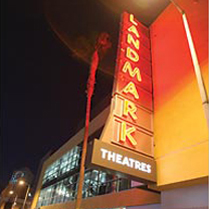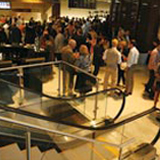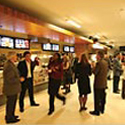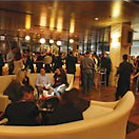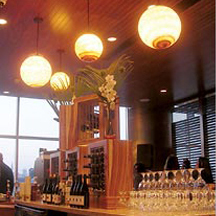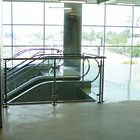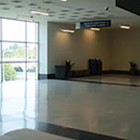Landmark Theatres Contact Information
Landmark Theatres is the nation's largest theatre chain dedicated primarily to exhibiting and marketing independent film. Landmark is a recognized leader in the industry for providing consistently diverse and entertaining film product in a sophisticated adult-oriented atmosphere to its customers. Click here for a partial list of our achievements.
Since its inception in 1974, Landmark has grown to 58 theatres in 23 markets. Landmark is known for both its award winning historic theatres, such as the Tivoli in St. Louis, the Inwood in Dallas and the Oriental in Milwaukee, and and also for its newer theatres, including the Bethesda Row Cinema in Washington, D.C. and the Keystone Art Cinema in Indianapolis. The Landmark flagship theatre in West Los Angeles opened in June 2007 and two additional theatres, the Harbor East Cinema on Baltimore's Inner Harbor and The Landmark Theatre in Greenwood Village (Denver), are scheduled to open later this year.
Landmark is at the forefront of exhibition, providing customers with a number of amenities including the latest in film, digital and sound technology, the widest selection of concession items, in-theatre sales of DVDs, books and CDs as well as Landmark's signature brand of customer service.
Landmark Theatres is part of the Wagner/Cuban companies, a vertically-integrated group of media properties co-owned by Todd Wagner and Mark Cuban that also includes Magnolia Pictures, Magnolia Home Entertainment, HDNet Films, 2929 Productions, HDNet and HDNet Movies.

A Brief History of Landmark
Landmark Theatres began its ascent in 1974 with the acquisition of West Los Angeles' historic Nuart Theatre, the circuit's venerable flagship. Shortly after christening the Nuart, Landmark opened the Ken Cinema in San Diego and other outlets showcasing classic American and foreign films and cult features that changed nightly. This repertory-style format, coming before VCRs, thrived among college students and others who happily endured long lines to see favorites like Harold and Maude, King of Hearts and Pink Flamingos, the types of films that Landmark supported long before most other theatre chains. To make moviegoers take notice, the growing chain marketed its schedule by distributing free monthly calendars throughout each theatre's city. And, with the kind of initiative that remains one of its greatest strengths, the company aggressively staged grassroots promotions.
By the end of the '70s, Landmark had grown into the nation's largest repertory film circuit. In addition to the programming, increasingly loyal audiences were drawn to one-of-a-kind, historic venues.
As the '80s dawned, repertory-style circuits faced increasing competition from the burgeoning home video market, so Landmark began to exhibit high quality, independent films and first-run foreign fare. The strategy worked, and more effort was channeled into expansion. In 1982, the chain merged with Santa Fe-based Movies, Inc. to acquire 12 additional screens in eight new cities in the South and Southwest, and in 1989, it merged with the Seattle-based Seven Gables circuit to add another 33 screens. Over the next five years (during which time the Samuel Goldwyn Company bought Landmark), it added nearly 30 more screens in the San Francisco Bay Area. Almost half of them were in berkeley, a hot market for offbeat art houses that drew students from the city's bustling university.
In the early '90s, Landmark began multimillion-dollar renovations of its historic buildings, and, embarking on a new era, began developing new multiplex theatres of its own for the first time. The big push came in 1995, when the company opened three multiplexes, each architecturally distinct, in one year: the Lagoon Cinema in Minneapolis, the Embarcadero Center Cinema in San Francisco and the Kendall Square Cinema in Cambridge, MA. Expansion continued in 1998 as Landmark was acquired by Dallas-based Silver Cinemas Inc. and opened the Plaza Frontenac Cinema in St. Louis and the Embassy Cinema in Waltham, MA. In March of 2000, Landmark's Century Centre Cinema opened in Chicago to phenomenal business. Landmark's universally acclaimed Sunshine Cinema in New York City opened the following year.
After the company's purchase by Todd Wagner and Mark Cuban in 2003, Landmark Theatres added even more screens, including the hip Magnolia theatre located in Dallas. Our most recent constructions include the Keystone Art Cinema, opened in Indianapolis in December of 2005, and the E Street Cinema, opened in Washington D.C. in January of 2004. Landmark Theatres is committed to expanding its nationwide footprint, with three new theatres opening in 2007: Landmark Harbor East, a brand new 7-screen theatre in Baltimore, located directly on the water in the heart of the city; The Landmark Theatre in Greenwood Village, 6 screens located in one of South Denver's fastest growing, lifestyle developments; and our new flagship theatre, The Landmark, featuring 12 screens in the completely renovated Westside Pavilion Shopping Center in West Los Angeles.
Still, no matter how large it grows, the circuit continues to operate hand-in-hand with local communities to support the art of film. With its mix of historic and new theatres Landmark Theatres remains committed to exhibiting meaningful films that need to be seen.

